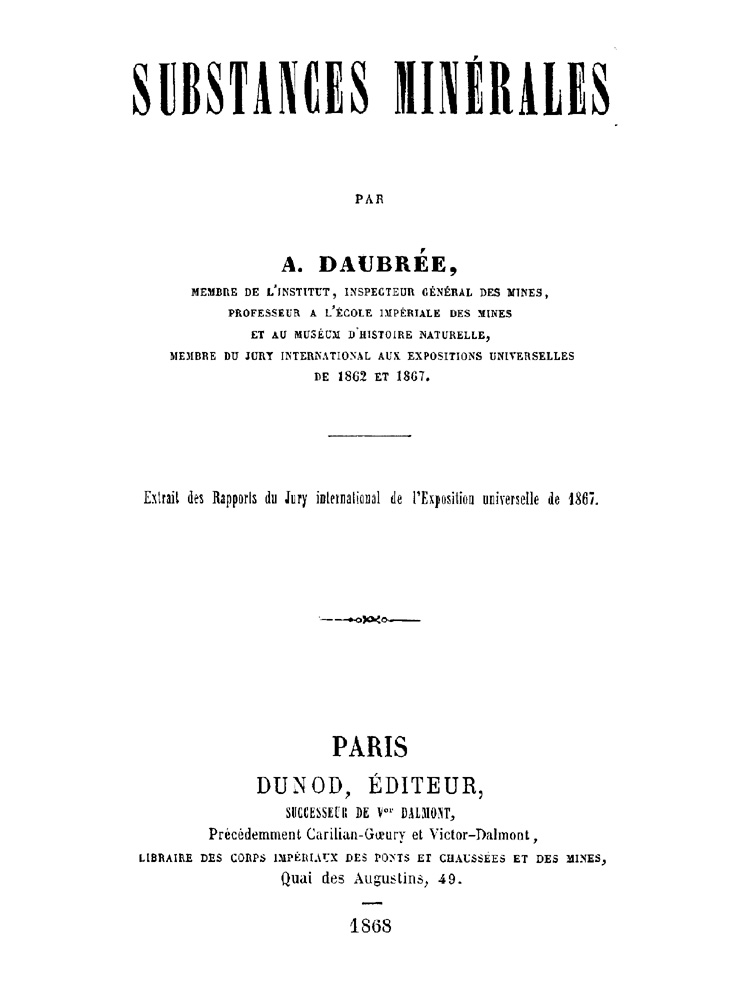DAUBRéE, Gabriel-Auguste.
(1814 – 1896)
Daubrée studied at the École Polytechnique in Paris, becoming a qualified mining engineer in 1834. He was placed in charge of the mines at Bas-Rhin, Alsace in 1838. Later he was appointed professor of mineralogy and geology at the University of Strasbourg. In 1859, Daubrée became engineer of all mining operations in France. Named professor of geology at the Museum of Natural History in Paris in 1861, he also became a professor of mineralogy at the École des Mines in Paris. Daubrée was appointed the director of this institution in 1872. Recipient of many honors including the Wollaston Medal from the Geological Society of London, 1880. F.R.S., 1881. Member of the French Academy of Science to which he was elected a vice president and then president in 1878 and 1879, respectively.
Biographical references: ABF: I 282,1-95. • Barr, Index to Biographical Fragments, 1973: 63. • DSB: 3, 586-7. • Encyclopaedia Britannica, 11th edition. • Lambrecht & Quenstedt, Catalogus, 1938: 105. • Poggendorff: 1, col. 526, 3, 329-30 & 4, 299. • Sarjeant, Geologists, 1980: 2, 852-3 & Suppl. 2 (1995), 1, 560. • WBI. • World Who's Who in Science: 412.
1. French, 1852.
Description | Géologique Et Minéralogique | Du Department | D Bas-Rhine, | Par | M.A. Daubrée, | [...2 lines of titles and memberships...] | [rule] | Publiée par décision du Conseil général du départment. | [ornate rule] | Veuve Berger-Levrautl Et Fils, Libraires. | [Imprint separated into 2 columns with a vertical bar between:] Paris, | Rue Des Saintes-Pères, 8. | [vertical rule] | Strasbourg, | Rue Des Juifs, 26.
8°: π2 *8 1-298 302 318 329; 260l.; [4], [I]-XVI, 1-500, [2] p., 4 folded, hand-colored plates (geological cross sections) and one large folding colored map.
Contents: [2 pgs], Half title page, verso "Strasbourg, Imprimerie De G. Silbermann."; [2 pgs], Title page, verso blank.; [I]-IV, "Avant-Propos."-dated 1852.; [V]-XVI, "Introduction."; 1-468, Text.; [469]-500, "Table Des Matières."; [1 pg], "Errata."; [1 pg], Blank.; [At end], 4 folding hand-colored plates and one map.
Very scarce. A topographical mineralogy describing the geology and mineralogy of the Bas-Rhin region of France, including four geological cross-sections and one geoloigcal map.
Bibliographical references: BL [7107.aaa.18.].
2. French, 1867.
Classification adoptée pour la collection des roches du Muséum d'Histoire Naturelle de Paris. Paris, 1867.
8°: ix. 47 p. Very scarce.
Bibliographical references: BL [7108.b.55.(10.)].

3. French, 1868.
Substances Minérales | Par | A. Daubrée | [...5 lines of titles and memberships...] | [rule] | Extrait des Rapports du Jury international de l'Exposition universelle de 1867. | [ornate rule] | Paris | Dunod, Éditeur, | Succeseur De Vor Dalmont, | Précédemment Carilian-Gœury et Victor-Dalmont, | Libraire Des Corps Impériaux Des Ponts Et Chaussées Et Des Mines, | Quai des Augustins, 49. | [rule] | 1868.
8°: [1]-218 222; 170l.; [1]-340 p. Page size: 208 x 118 mm.
Contents: [1-2], Half title page, "Substances Minérales | [rule] | Extrait des Rapports du Jury international de l'Exposition universelle de 1867," verso "Paris-Imprié par E. Thunot et Ce Racine, 26."; [3-4], Title page, verso blank.; [5]-331, Text.; [332], Blank.; [333]-340, "Table Des Matières."
Very scarce. The first pages of the text (pp. 5-24) act as an introduction, which includes some historical review and general observations. The second section (pp. 25-80) describes combustibles as they are found in the various countries of the world. The third chapter (pp. 81-114) covers the bitumens. The fourth (pp. 115-148) describes the mineralogy of iron, while the fifth section (pp. 149-228) concerns the mineralogy of other metals besides iron. The sixth part (pp. 229-292) is on the minerals that serve in the chemical industry. Part seven (pp. 295-505) concerns minerals used as ornaments, including gemstones. Section eight (pp. 506-524) describes various industrial minerals, including quartz, kaolin, feldspar, mica, graphite, etc. Finally, chapter ten (pp. 525-331) provides an overview of rocks and petrology. Through out the mineralogical sections, localities of specific minerals around the world are indicated.
Original issue, 1867: Daubrée's work originally appeared in the Reports of the International Jury of the 1867 Paris Universal Exposition under the title:Exposition Universelle De 1867 | A Paris | [ornate rule] | Rapports Du Jury International | Publiés Sous La Direction | De M. Michel Chevalier | [ornate rule] | Substances Minérales | Par | A. Daubrée | [...2 lines of titles and memberships...] | [ornament] | Paris | Imprimerie Et Librairie Administratives De Paul Dupont | 45, Rue De Grenelle-Saint-Honoré, 45. | [rule] | 1867.Its importance was recognized, and subsequently the work was reissued as the independent book described above.
Bibliographical references: BL [no copy listed]. • Dana's 7th (Bibliography): 69. • NUC.
4. French, 1879.
Etudes Synthetiques de Geologie Experimentale ... Paris, Dunod, 1879.
2 parts. [Part 1] 8°: 478 p. [Part 2] 8°: 350 p. There are numerous photo-lithos, chromo-lithos, plates & maps.
Very scarce. This is Daubree's most important work. It is the summary of his research into geochemical processes. The chapters deal with different topics: geochemical processes, applications of engineering principles to the understanding of geological structures and mechanical problems, e.g., the folding and torsion of land structures. This work was of lasting significance and is still referred to today. There are very interesting chapters devoted to the effects of dyanamite explosions, mineralization patterns (beautifully illustrated), meteors, artificial minerals, etc.
Related work, 1867: Rapport sur les progrès de la géologie expérimentale. Recueil de rapports sur les progrès des sciences en France. Paris, Imprimerie Imperiale, 1867. 4°: [4], 142 p. Application of the experimental method to chemical phenomena. Artificial production or synthesis of minerals. - Application of the experimental method to physical and mechanical phenomena. - Metamorphism. - Meteorites. Daubrée was a professor with the Natural history museum, member of the Academy of Science and principal of the Mines. DSB 3, 587.
Bibliographical references: American Journal of Science: 3rd Series, 18 (1879), 150-1 & 19 (1880), 386-90 [reviews of parts I & II by J.L. Smith]. • BL [07108.k.8.]. • DSB: 3, 586-7.
.